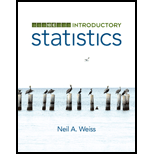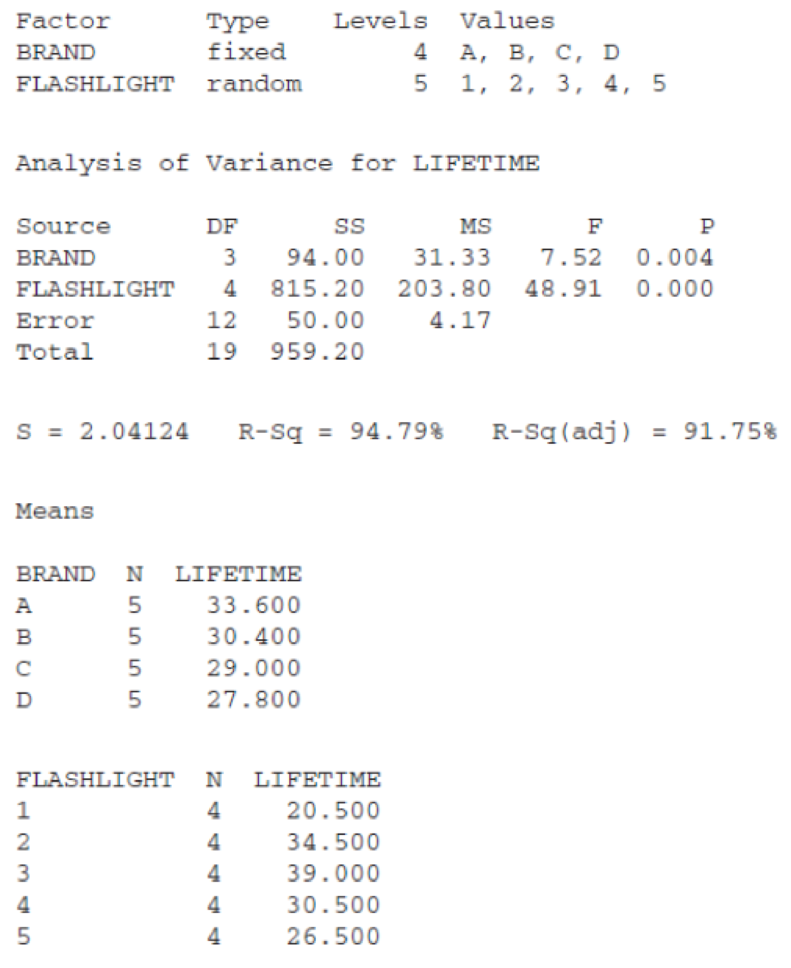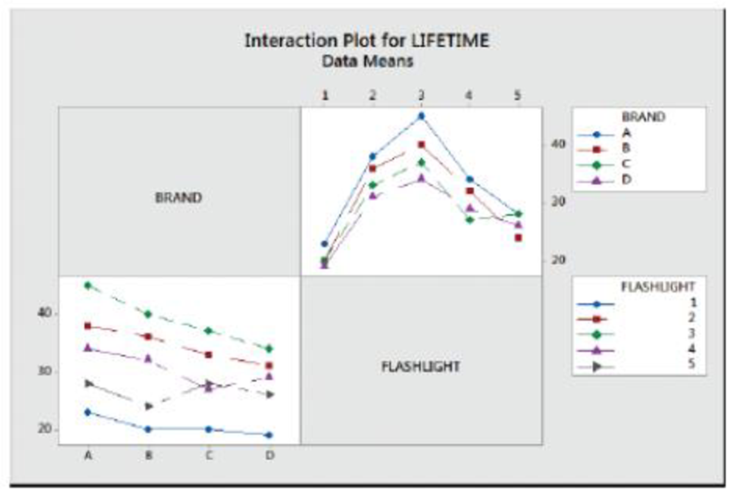
Introductory Statistics (10th Edition)
10th Edition
ISBN: 9780321989178
Author: Neil A. Weiss
Publisher: PEARSON
expand_more
expand_more
format_list_bulleted
Concept explainers
Textbook Question
Chapter C.7, Problem 134E
Battery Lifetimes. Refer to Exercise C.123. Use the technology of your choice to obtain computer output similar to that in Outputs C.42 and C.43 on page C-87.
OUTPUT C.42
Output for Exercise C. 123
ANOVA: LIFETIME versus BRAND, FLASHLIGHT

OUTPUT C.43
Output for Exercise C.123

Expert Solution & Answer
Want to see the full answer?
Check out a sample textbook solution
Students have asked these similar questions
Most people know that the probability of getting a head when you flip a fair coin is . You want to use the relative frequency of the event to show that the probability is . How many times should you simulate flipping the coin in the experiment? Would it be better to use 300 trials or 3000 trials? Explain.
The qualified applicant pool for eight management trainee positions consists of ten women and six men. How many different groups of applicants can be selected for the positions
You want to make a salad from whatever vegetable you have in the fridge. You have seven different tomatoes. There are 2 red tomatoes, 4 yellow tomatoes, and one black tomato in the fridge. You have three different bell peppers. There is 1 red pepper, 1 yellow pepper, and 1 green pepper. What is the probability of randomly choosing a vegetable and getting a red tomato, and a green pepper? Round your answer to four decimal places.
Chapter C Solutions
Introductory Statistics (10th Edition)
Ch. C.1 - Define the following terms: a. factor b. levels of...Ch. C.1 - A three-way factorial design has Factor A at 3...Ch. C.1 - A four-way factorial design has Factor A at 2...Ch. C.1 - A three-way factorial design has Factor A at 6...Ch. C.1 - Answer true or false to each of the following...Ch. C.1 - Prob. 8ECh. C.1 - Answer true or false to each of the following...Ch. C.1 - Prob. 10ECh. C.1 - In each of Exercises C.11C.17 identify the...Ch. C.1 - In each of Exercises C.11C.17 identify the...
Ch. C.1 - In each of Exercises C.11C.17 identify the...Ch. C.1 - In each of Exercises C.11C.17 identify the...Ch. C.1 - In each of Exercises C.11C.17 identify the...Ch. C.1 - Prob. 16ECh. C.1 - In each of Exercises C.11C.17 identify the...Ch. C.2 - Consider a 3 4 ANOVA. a. Identify the number of...Ch. C.2 - Consider a 4 2 ANOVA. a. Identify the number of...Ch. C.2 - Prob. 25ECh. C.2 - Prob. 26ECh. C.2 - Prob. 27ECh. C.2 - Prob. 28ECh. C.2 - In two-way ANOVA, identify what we mean by a. a...Ch. C.2 - In two-way ANOVA, what does it mean we have...Ch. C.2 - In Exercises C.31C.33, we have presented partially...Ch. C.2 - Prob. 32ECh. C.2 - Prob. 33ECh. C.2 - Prob. 34ECh. C.2 - State the null and alternative hypotheses for a...Ch. C.2 - Prob. 36ECh. C.2 - In a two-way ANOVA, why is the test for...Ch. C.2 - Prob. 38ECh. C.2 - Prob. 39ECh. C.2 - Prob. 40ECh. C.2 - Prob. 41ECh. C.2 - Referring to Exercise C.38, for which part(s) is...Ch. C.2 - Prob. 43ECh. C.2 - Prob. 44ECh. C.2 - Prob. 45ECh. C.2 - Prob. 46ECh. C.3 - In each of Exercises C.47C.53, we have presented a...Ch. C.3 - In each of Exercises C.47C.53, we have presented a...Ch. C.3 - Prob. 49ECh. C.3 - Prob. 50ECh. C.3 - Prob. 51ECh. C.3 - Prob. 52ECh. C.3 - Prob. 53ECh. C.3 - Prob. 54ECh. C.3 - Prob. 55ECh. C.3 - Prob. 56ECh. C.3 - Prob. 57ECh. C.3 - Prob. 58ECh. C.3 - Prob. 59ECh. C.3 - Prob. 60ECh. C.3 - Prob. 61ECh. C.3 - Prob. 62ECh. C.3 - Prob. 63ECh. C.3 - Prob. 64ECh. C.3 - Prob. 65ECh. C.3 - Prob. 66ECh. C.3 - Prob. 67ECh. C.3 - Prob. 68ECh. C.3 - Prob. 69ECh. C.3 - Prob. 70ECh. C.3 - Prob. 71ECh. C.4 - In an experiment with two factors, A and B, what...Ch. C.4 - If the confidence interval for the difference...Ch. C.4 - Prob. 74ECh. C.4 - Prob. 75ECh. C.4 - Let Factor A have three levels and Factor B have...Ch. C.4 - In Exercises C.77C.83, we have repeated the...Ch. C.4 - Prob. 78ECh. C.4 - In Exercises C.77C.83, we have repeated the...Ch. C.4 - Prob. 80ECh. C.4 - In Exercises C. 77-C.83. we have repeated the...Ch. C.4 - In Exercises C.77C.83, we have repeated the...Ch. C.4 - Prob. 83ECh. C.4 - Household Income. Refer to Exercise C.77. Use the...Ch. C.4 - Prob. 85ECh. C.4 - Prob. 86ECh. C.4 - Highway Signs. Refer to Exercise C.80. Use the...Ch. C.4 - Hospital Stays. Refer to Exercise C.81. Use the...Ch. C.4 - Prob. 89ECh. C.4 - Advertising and Sales. Refer to Exercise C.83. Use...Ch. C.5 - In each of Exercises C.91C.97, identify the...Ch. C.5 - Prob. 92ECh. C.5 - In each of Exercises C.91C.97, identify the...Ch. C.5 - In each of Exercises C.91C.97, identify the...Ch. C.5 - In each of Exercises C.91C.97, identify the...Ch. C.5 - In each of Exercises C.91C.97, identify the...Ch. C.5 - In each of Exercises C.91C.97, identify the...Ch. C.6 - What is the purpose of blocking in a randomized...Ch. C.6 - Prob. 104ECh. C.6 - Prob. 105ECh. C.6 - Prob. 106ECh. C.6 - Answer true or false to the following statements...Ch. C.6 - Prob. 108ECh. C.6 - In randomized block ANOVA, what is meant when we...Ch. C.6 - Prob. 110ECh. C.6 - State the null and alternative hypotheses for a...Ch. C.6 - Identify, give the degrees of freedom for, and...Ch. C.6 - Prob. 113ECh. C.6 - Prob. 114ECh. C.6 - Prob. 115ECh. C.6 - Prob. 116ECh. C.6 - Prob. 117ECh. C.6 - Prob. 118ECh. C.7 - In each of Exercises C.119C.125, we have presented...Ch. C.7 - Prob. 120ECh. C.7 - Prob. 121ECh. C.7 - Prob. 122ECh. C.7 - Prob. 123ECh. C.7 - Prob. 124ECh. C.7 - Prob. 125ECh. C.7 - Prob. 126ECh. C.7 - Prob. 127ECh. C.7 - Prob. 128ECh. C.7 - Prob. 129ECh. C.7 - Prob. 130ECh. C.7 - Prob. 131ECh. C.7 - Penicillin Yields. Refer to Exercise C.121. Use...Ch. C.7 - Prob. 133ECh. C.7 - Battery Lifetimes. Refer to Exercise C.123. Use...Ch. C.7 - Prob. 135ECh. C.7 - Prob. 136ECh. C.7 - Prob. 137ECh. C.7 - Prob. 138ECh. C.7 - Prob. 139ECh. C.7 - Prob. 140ECh. C.7 - Prob. 141ECh. C.7 - Golf Ball Driving Distances. Refer to Exercise...Ch. C.7 - Prob. 143ECh. C.7 - Analgesic Effectiveness. Refer to the analgesic...Ch. C.8 - In a randomized block experiment with treatment...Ch. C.8 - If the confidence interval for the difference...Ch. C.8 - The parameter v for the q-curve in a Tukey...Ch. C.8 - Prob. 148ECh. C.8 - Prob. 149ECh. C.8 - Prob. 150ECh. C.8 - Prob. 151ECh. C.8 - Prob. 152ECh. C.8 - Prob. 153ECh. C.8 - Prob. 154ECh. C.8 - Mileage for Gasoline Brands. Refer to Exercises...Ch. C.8 - Prob. 156ECh. C.8 - Prob. 157ECh. C.8 - Barley Variety Yields. Refer to Exercises C.125...Ch. C.8 - Prob. 159ECh. C.9 - Of which test is the Friedman test a nonparametric...Ch. C.9 - Prob. 161ECh. C.9 - Prob. 162ECh. C.9 - Prob. 163ECh. C.9 - Fill in the following blank: If the null...Ch. C.9 - Prob. 165ECh. C.9 - For a Friedman test to compare the means of six...Ch. C.9 - Prob. 167ECh. C.9 - In each of Exercises C.168C.I74, determine whether...Ch. C.9 - Prob. 169ECh. C.9 - Prob. 170ECh. C.9 - Prob. 171ECh. C.9 - Prob. 172ECh. C.9 - Prob. 173ECh. C.9 - Prob. 174ECh. C.9 - Prob. 175ECh. C.9 - Prob. 176ECh. C.9 - Prob. 177ECh. C.9 - Prob. 178ECh. C.9 - Prob. 179ECh. C.9 - Prob. 180ECh. C.9 - Prob. 181ECh. C - Discuss the differences between a designed...Ch. C - In a complete factorial design, how do you...Ch. C - Prob. 3RPCh. C - Prob. 4RPCh. C - Prob. 5RPCh. C - Prob. 6RPCh. C - Prob. 7RPCh. C - For a two-way ANOVA: a. List and interpret the...Ch. C - Prob. 9RPCh. C - Prob. 10RPCh. C - State the assumptions for a two-way ANOVA and...Ch. C - Prob. 12RPCh. C - Prob. 13RPCh. C - Prob. 14RPCh. C - This problem concerns multiple comparisons. a....Ch. C - Cereal Sales. Refer to Problem 13. Perform...Ch. C - Explain why it is sometimes preferable to employ a...Ch. C - For a randomized block ANOVA: a. List and...Ch. C - Prob. 19RPCh. C - Prob. 20RPCh. C - Prob. 21RPCh. C - Prob. 22RPCh. C - Prob. 23RPCh. C - Prob. 24RPCh. C - Prob. 25RPCh. C - Identify the nonparametric alternative to the...Ch. C - Explain the logic behind the Friedman test.Ch. C - Prob. 28RPCh. C - Prob. 29RPCh. C - Prob. 30RPCh. C - Prob. 31RPCh. C - Prob. 32RPCh. C - Prob. 33RPCh. C - Prob. 34RPCh. C - Prob. 35RPCh. C - Prob. 36RP
Knowledge Booster
Learn more about
Need a deep-dive on the concept behind this application? Look no further. Learn more about this topic, statistics and related others by exploring similar questions and additional content below.Similar questions
- uppose automobile insurance companies gave annual premiums for top-rated companies in several states. The figure below shows box plots for the annual premium for urban customers in three states. Which state offers the lowest premium? Which state offers the highest premium?arrow_forwardWing Foot is a shoe franchise commonly found in shopping centers across the United States. Wing Foot knows that its stores will not show a profit unless they gross over $940,000 per year. Let A be the event that a new Wing Foot store grosses over $940,000 its first year. Let B be the event that a store grosses over $940,000 its second year. Wing Foot has an administrative policy of closing a new store if it does not show a profit in either of the first two years. Assume that the accounting office at Wing Foot provided the following information: 58% of all Wing Foot stores show a profit the first year; 72% of all Wing Foot store show a profit the second year (this includes stores that did not show a profit the first year); however, 86% of Wing Foot stores that showed a profit the first year also showed a profit the second year. Compute P(B|Ac). Round your answer to the nearest hundredth.arrow_forwardYou draw two cards from a standard deck of 52 cards, but before you draw the second card, you put the first one back and reshuffle the deck. If you get a3on the first card, find the probability of drawing a 3 for the second card.arrow_forward
- Do bonds reduce the overall risk of an investment portfolio? Let x be a random variable representing annual percent return for the Vanguard Total Stock Index (all Stocks). Let y be a random variable representing annual return for the Vanguard Balanced Index (60% stock and 40% bond). For the past several years, assume the following data. Compute the coefficient of variation for each fund. Round your answers to the nearest tenth. x: 14 0 37 21 35 23 24 -14 -14 -17 y: 8 -2 29 17 22 17 17 -2 -3 -8arrow_forwardWhat percentage of the general U.S. population have bachelor's degrees? Suppose that the Statistical Abstract of the United States, 120th Edition, gives the following percentage of bachelor’s degrees by state. For convenience, the data are sorted in increasing order. 17 18 18 18 19 20 20 20 21 21 21 21 21 22 22 22 22 22 23 23 24 24 24 24 24 25 25 25 25 26 26 26 26 26 26 27 27 27 28 28 28 29 29 31 31 32 32 34 35 38 Illinois has a bachelor's degree percentage rate of about 18%. Into what quartile does this rate fall?arrow_forwardWhat percentage of the general U.S. population have bachelor's degrees? Suppose that the Statistical Abstract of the United States, 120th Edition, gives the following percentage of bachelor’s degrees by state. For convenience, the data are sorted in increasing order. 17 18 18 18 19 20 20 20 21 21 21 21 21 22 22 22 22 22 23 23 24 24 24 24 24 25 25 25 25 26 26 26 26 26 26 27 27 27 28 28 28 29 29 31 31 32 32 34 35 38 Illinois has a bachelor's degree percentage rate of about 18%. Into what quartile does this rate fall?arrow_forward
- Find the range for the following sample data. x 23 17 11 30 27arrow_forwardDo bonds reduce the overall risk of an investment portfolio? Let x be a random variable representing annual percent return for the Vanguard Total Stock Index (all Stocks). Let y be a random variable representing annual return for the Vanguard Balanced Index (60% stock and 40% bond). For the past several years, assume the following data. Compute the sample mean for x and for y. Round your answer to the nearest tenth. x: 11 0 36 22 34 24 25 -11 -11 -22 y: 9 -3 28 14 23 16 14 -3 -4 -9arrow_forwardDo bonds reduce the overall risk of an investment portfolio? Let x be a random variable representing annual percent return for the Vanguard Total Stock Index (all Stocks). Let y be a random variable representing annual return for the Vanguard Balanced Index (60% stock and 40% bond). For the past several years, assume the following data. Compute the range for variable y. X 12 0 36 21 35 23 24 -12 -12 -21 Y 10 -2 26 15 22 18 15 -2 -3 -10arrow_forward
- Do bonds reduce the overall risk of an investment portfolio? Let x be a random variable representing annual percent return for the Vanguard Total Stock Index (all Stocks). Let y be a random variable representing annual return for the Vanguard Balanced Index (60% stock and 40% bond). For the past several years, assume the following data. Compute the range for variable y. X 12 0 36 21 35 23 24 -12 -12 -21 Y 10 -2 26 15 22 18 15 -2 -3 -10arrow_forwardDo bonds reduce the overall risk of an investment portfolio? Let x be a random variable representing annual percent return for the Vanguard Total Stock Index (all Stocks). Let y be a random variable representing annual return for the Vanguard Balanced Index (60% stock and 40% bond). For the past several years, assume the following data. Compute the range for variable x. X 15 0 37 23 33 25 26 -15 -15 -23 Y 6 -1 28 18 24 17 18 -1 -2 -6arrow_forward7.16. If the probability density of X is given by g kx³ for x>0 f(x) = (1+2x)6 0 10-01, elsewhere trolls inf ( 2X density of the random variable Y = where k is an appropriate constant, find the probability 1+2X distribution of Y, and thus determine the value of k. 7 Identify thearrow_forward
arrow_back_ios
SEE MORE QUESTIONS
arrow_forward_ios
Recommended textbooks for you
 Big Ideas Math A Bridge To Success Algebra 1: Stu...AlgebraISBN:9781680331141Author:HOUGHTON MIFFLIN HARCOURTPublisher:Houghton Mifflin Harcourt
Big Ideas Math A Bridge To Success Algebra 1: Stu...AlgebraISBN:9781680331141Author:HOUGHTON MIFFLIN HARCOURTPublisher:Houghton Mifflin Harcourt Linear Algebra: A Modern IntroductionAlgebraISBN:9781285463247Author:David PoolePublisher:Cengage Learning
Linear Algebra: A Modern IntroductionAlgebraISBN:9781285463247Author:David PoolePublisher:Cengage Learning Glencoe Algebra 1, Student Edition, 9780079039897...AlgebraISBN:9780079039897Author:CarterPublisher:McGraw Hill
Glencoe Algebra 1, Student Edition, 9780079039897...AlgebraISBN:9780079039897Author:CarterPublisher:McGraw Hill Functions and Change: A Modeling Approach to Coll...AlgebraISBN:9781337111348Author:Bruce Crauder, Benny Evans, Alan NoellPublisher:Cengage Learning
Functions and Change: A Modeling Approach to Coll...AlgebraISBN:9781337111348Author:Bruce Crauder, Benny Evans, Alan NoellPublisher:Cengage Learning
 Holt Mcdougal Larson Pre-algebra: Student Edition...AlgebraISBN:9780547587776Author:HOLT MCDOUGALPublisher:HOLT MCDOUGAL
Holt Mcdougal Larson Pre-algebra: Student Edition...AlgebraISBN:9780547587776Author:HOLT MCDOUGALPublisher:HOLT MCDOUGAL

Big Ideas Math A Bridge To Success Algebra 1: Stu...
Algebra
ISBN:9781680331141
Author:HOUGHTON MIFFLIN HARCOURT
Publisher:Houghton Mifflin Harcourt

Linear Algebra: A Modern Introduction
Algebra
ISBN:9781285463247
Author:David Poole
Publisher:Cengage Learning

Glencoe Algebra 1, Student Edition, 9780079039897...
Algebra
ISBN:9780079039897
Author:Carter
Publisher:McGraw Hill

Functions and Change: A Modeling Approach to Coll...
Algebra
ISBN:9781337111348
Author:Bruce Crauder, Benny Evans, Alan Noell
Publisher:Cengage Learning


Holt Mcdougal Larson Pre-algebra: Student Edition...
Algebra
ISBN:9780547587776
Author:HOLT MCDOUGAL
Publisher:HOLT MCDOUGAL
Probability & Statistics (28 of 62) Basic Definitions and Symbols Summarized; Author: Michel van Biezen;https://www.youtube.com/watch?v=21V9WBJLAL8;License: Standard YouTube License, CC-BY
Introduction to Probability, Basic Overview - Sample Space, & Tree Diagrams; Author: The Organic Chemistry Tutor;https://www.youtube.com/watch?v=SkidyDQuupA;License: Standard YouTube License, CC-BY